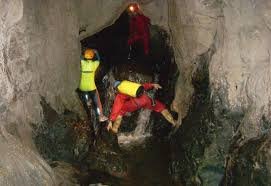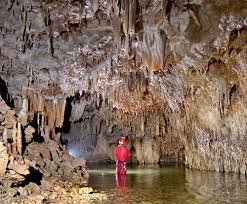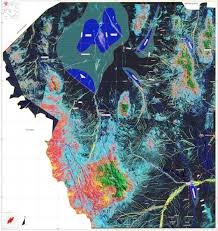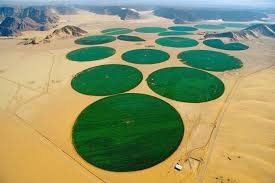On many occasions in casual conversations and on environmental issues, touch the issue of what is fossil water and about the use of it today, and when I ask the question many people are stunned because they have the perception that when they talk Something fossil is merely related to extinct animals millions of years ago. The idea of this post is to clarify certain doubts to provide information on the environmental issue and generate debates discussions.

WHAT IS FOSSIL WATER?
Fossil water is groundwater that has remained in an aquifer between 12,000 and 40,000 years, after constant geological changes was trapped in caverns and galleries beneath the subsoil thus becoming fossilized water.
.jpg)
WHAT THREATENS FOSSIL WATER RESERVES?
The purity of fossil water is indescribable, since it has been trapped in underground rivers and thus has remained for millennia, however at present, it is being threatened by modern human activity, such as atomic-nuclear experiments, chemical pesticide fungicidal agents of the agro-industry. As a result of this aggressive and constant pollution, global warming occurs, due to warming, today researchers have detected traces of current rainwater, on the other hand, the defrosting of the poles is also mixing with fossilized water , although it is in most cases more than 250 meters from the surface of the earth. According to recent studies, it was concluded that this type of water is more vulnerable every day, due to invasive industrial practices.

IMPORTANCE OF FOSSIL WATER
Much of the fresh water from precipitation infiltrates the soil and can either end up emerging in the form of springs or river births, or remain under the ground, housed in aquifers, for thousands and sometimes millions of years, isolating itself for a long time from its normal cycle, making it unusable for most living beings. We talk about fossil water.
Studies using radiocarbon show that some aquifers contain sealed and "fossilized" water since the last glaciation, that is, more than 40,000 years ago. Possibly the record of antiquity has a bag of water discovered in May 2013 in a Canadian mine near the town of Timmins, at 2400 meters deep. This water comes from the Precambrian, with an age of between 1500 and 2640 million years, that is, almost half of the life of our planet. One of the largest fossil water reservoirs is located in Ogallala, United States, but those of the African continent stand out. In North Africa alone, there are half a million cubic kilometers of fossil water. UNESCO revealed only half a year ago, in September 2013, the existence of five large underground aquifers in Kenya.

Fossil water plays an essential role in arid and semi-arid environments, where rainfall is scarce and irregular. In these environments we find two main types of plants: species with short life cycles, whose seeds germinate in response to the rains and that survive while the surface layer remains sufficiently moist, and woody species with very deep roots that survive thanks to the waters underground. The fact that these plants that take advantage of the deep water survive is key to the functioning of the ecosystems, their productivity, the correction of erosion and torrential avenues and the provision of numerous services that depend on accessibility to the water table. However, the human being is not content with this global deep water service and prefers to drink or market them. But what real price could we put on a cocktail that carried water as incredible as Timmins?
DRINKKING FOSSIL WATER IS A NEW ALTERNATIVE?
Drinking fossil water is common in many regions and has been done throughout our history as soon as we had minimal technology to land the earth. Discoveries such as those of fossil water in the subsoil of Kenya revealed last year have a great impact on the human population as we speak of one of the driest territories in the world. The availability of fresh water in these regions of the planet is crucial for social and gender equality, as well as for education, and not only for health, as concluded in a recent OECD meeting and in various UN reports. . It is estimated that these aquifers will guarantee water supply to Kenya for the next 70 years, a country where 17 of its 41 million inhabitants do not have access to drinking water. In the meantime, what will be planned with those millions of people when the fossil water runs out?
After a period of great rainfall, as it has been last winter, it seems that the drought ghost has dissipated in our latitudes. It occurs after all the "good" years in which we forget our geography and our weather. But when we talk about key resources such as water, and a process-based exploitation of thousands of years, what happens in a given winter should not weigh much on our decisions and concerns. A rainy year in dry areas such as the Mediterranean region is "water for today and hunger for tomorrow" and especially given the well-confirmed expectations of more arid scenarios due to climate change. We will continue drilling the earth in search of an underground water that has taken thousands of years to be stored to remove it from its shelter and consume it in a short time. Accelerating the water cycle we will stop being a renewable resource since we extract it from a compartment (the ground) at a faster rate than it returns. The worrying thing is that it seems that this does not concern us.
The problem today is the scale and speed at which we are consuming this resource of very slow renewal. In dry regions like Libya, water is more valuable than fossil fuels as it is crucial for human consumption. In 1984, the Libyan government launched the The Great Man-Made River project and built an extensive network of pipes and reservoirs to bring the groundwater that is obtained from 1300 wells into the desert subsoil.
The underground water reservoirs give rise to a large number of natural lagoons, important for water and migratory birds, as well as for extensive agriculture in some areas. From the time the irrigation was generalized and more water began to be extracted than is recharged by infiltration of rainwater and the rivers and streams of the area. The water table drops to the point of natural surface discharges. Today it is a necessity to protect underground freshwater reserves, particularly in dry areas.

Similarly, in aquifers, which feed the coastal lagoons of many populations worldwide, they are undergoing intensive exploitation for both agricultural and urban use (especially in the tourist complexes). Although the decrease in piezometric levels has already caused the desiccation or severe reduction of the flood period of many of these lagoons, and international organizations express concern about their impact on National park ecosystems, but the strong interests associated with the exploitation of these aquifers continue to prevail.
More spectacular and with more irreversible effects is the extraction of water from the subsoil in the Arab Emirates, in the middle of the desert. The geological water extracted is used, among other things, to supply an expensive artificial snow track. And they plan ambitious proposals for exploitation of African aquifers. Fossil water generates conflicts of all kinds, not only warlike and diplomatic but also ethical and humanitarian. Whose water is stored in a given aquifer but has been and is being collected in mountains and basins that belong to other regions and even other countries? Whose water is conserved thanks to the fact that it has not been overexploited for generations or that a great city has not been built right there? How do we justify watering a garden or emptying our droppings with geologically pure water that is worth much more than what is paid to supply companies per cubic meter?

reference source:
https://es.wikipedia.org/wiki/Agua_f%C3%B3sil
https://www.eldiario.es/cienciacritica/agua_fosil-acuifero-sequia-zonas_aridas-sobrexplotacion-agua_dulce-agua_subterranea_6_257984207.html
https://www.eldiario.es/cienciacritica/agua_fosil-acuifero-sequia-zonas_aridas-sobrexplotacion-agua_dulce-agua_subterranea_6_257984207.html
https://www.google.com/url?sa=i&source=images&cd=&cad=rja&uact=8&ved=2ahUKEwj256L_nZDmAhWFylkKHfktDX4QjB16BAgBEAM&url=http%3A%2F%2Fcinabrio.over-blog.es%2Farticle-kenia-halla-acuifero-subterraneo-con-agua-para-70-a-os-unesco-119998940.html&psig=AOvVaw0si591DeReq_JP7z7kkWRG&ust=1575144772895212
https://www.google.com/url?sa=i&source=images&cd=&cad=rja&uact=8&ved=0ahUKEwivwLDVmZDmAhXPuFkKHbByD2MQMwhgKBMwEw&url=https%3A%2F%2Fwww.venelogia.com%2Farchi
vos%2F4492%2F&psig=AOvVaw0fCYrFYNRMT0s-aWlw2SkM&ust=1575143697150415&ictx=3&uact=3
https://www.google.com/url?sa=i&source=images&cd=&cad=rja&uact=8&ved=0ahUKEwjN5uXziZDmAhVCrlkKHWCqC58QMwhYKAswCw&url=https%3A%2F%2Fmarcianosmx.com%2Fcenote-angelita-rio-salado-pozo-agua-dulce%2F&psig=AOvVaw37vUzjjwlHS5IQpCNG5e49&ust=1575139466131251&ictx=3&uact=3
if you like this kind of posts just SUPPORT to: 